Picture This, Picture That: How to Use the Potential of Art in Language Teaching
Magda Zawadzka is a teacher, teacher trainer, coach and translator. She teaches individual students and exam groups, runs training sessions and workshops for teachers. She is interested in the latest trends in teaching, creativity, as well as teaching languages through art, literature, and culture. Email: byronz@wp.pl
Introduction
I love art and I love quotes and that is how Andy Warhol, who once said: Don't think about making art, just get it done, became an inspiration for my own motto: Don't think about teaching through art, just get it done.
This article will, hopefully, guide you towards ‘getting it done’, towards effective and engaging ways of using art to learn, practise and produce language, stimulate reflection as well as creativity, a combination “devoutly to be wished” in any lesson.
The activities presented here are practical and can be easily adjusted to different levels while at the same time they afford an opportunity for both controlled language practise and spontaneous expression.
So, how are you today?
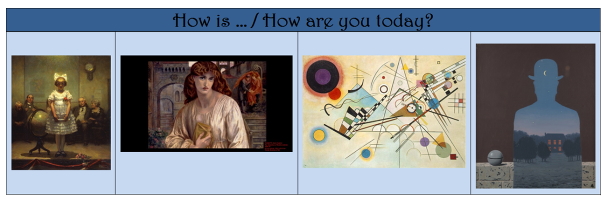
In this activity, which seeks to explore the connection between an emotional state and a visual representation, you can elicit from students how they are feeling at a particular moment. First show them the pictures and ask for a spontaneous feedback and then move on to the next step, which offers more vocabulary to do so.
If you sense that students are not ready to talk about their own feelings, you can choose to concentrate on the pictures themselves and analyse how the characters depicted in them feel.
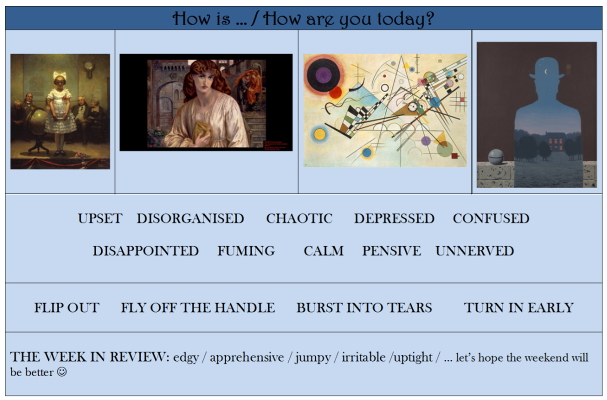
The list contains adjectives, phrases/phrasal verbs and synonyms (the week-in-review part). This exercise is a great springboard for a flipped lesson.
- Have students prepare their own versions of the exercise at home, together with pictures and vocabulary.
- They can either focus on the vocabulary from previous lessons or prepare their own lists.
- Their worksheets will create a ‘class gallery’ displayed on the walls – students walk around the classroom and explore it, asking their friends for explanations.
- Make sure everybody has a handout to write down new words/phrases from other students’ worksheets.
The pictures used in the exercise: Norman Rockwell – Young Valedictorian, Dante Gabriel Rossetti - Salutation of Beatrice, Wassily Kandinsky – Composition VIII, Rene Magritte – The Happy Donor
#vocabulary #emotions #flippedlesson #classgallery #findyourownpaintings
I spy with my little eye…
This activity has been designed to encourage students to look more closely. This is how it can be introduced:
- Show students the picture, without revealing its title and ask what it represents and what objects they can identify.(Helpful expressions: It could/might be, It looks like, I wonder what these circles could be, etc.)
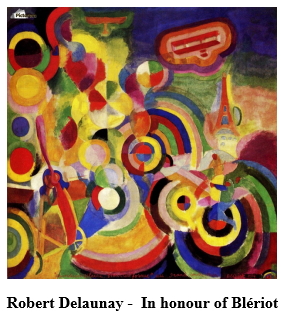
- Display this list of objects from the painting and ask them to find them in the picture.
A red biplane
A brown bird
A green bridge
A red propeller
A yellow wheel
A red tower
- Ask students to look up who Louis Blériot was (he built the first working, powered, piloted monoplane) and discuss how knowing who he was influenced what they were able to discover in the painting.
- Alternatively, you can show the picture first, get students to find out who Louis Blériot was and ask them to generate their own list of objects they can ‘spy’ in the painting.
# RobertDelaunay #lookclosely #notsoobvious #speculating
3. - Reimagining Famous Paintings
This activity gives students a chance to go beyond simple/suggested interpretations and personalise their response by making changes to the paintings.
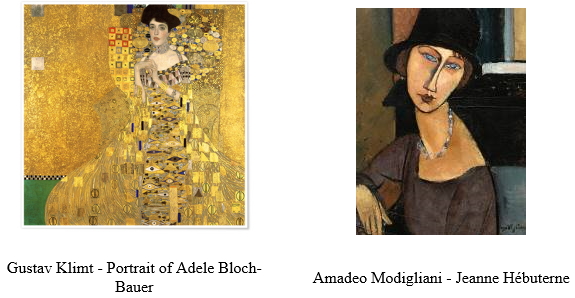
Prepare a selection of different portraits and have students complete the sentence below with their own ideas. It makes sense to have laminated copies and dry-erase markers for students to use.
If I painted this portrait now, I would …
- Add… (more black)
- Introduce … (new characters, such as…)
- Remove… (the background)
- Change… (the colour of)
- Give it a new title
…. because …..
It can be done as either a writing/speaking exercise or both. If that is the case, students do the written part individually and then discuss the changes in pairs. The paintings can also be displayed around the classroom; students present the changes to the whole class taking on a role of a gallery guide. This version is suitable for more advanced students, as it requires a bit more language work and preparation – make sure students watch some ‘art gallery talks’ to learn the language of this type of presentation.
#reimagining #Iwould #mywayofseeing #beaguide
4. The Art of Grammar
Can art and grammar go together? Yes! Here is an idea how to ‘smuggle’ as much art as possible into a language class, combining an emotional response to a piece of art with grammar practice.
Prepare different paintings/photos with captions showing people’s reactions to them. (alternatively, you can ask students to jot down their own). Students work in pairs and use the structures from the grammar wheel to comment on them, e.g.:
I’m confused
- Never have I been so confused when looking at a picture.
- I wish I understood what it is about.
- I really love this painting, although I’m a bit confused about its meaning
- Supposing you got this picture as a present, would you hang it in your bedroom?
- If I was given this picture, I wouldn’t know how to react.
This particular grammar wheel was prepared for advanced students, but can be changed to reflect your students’ level and needs.
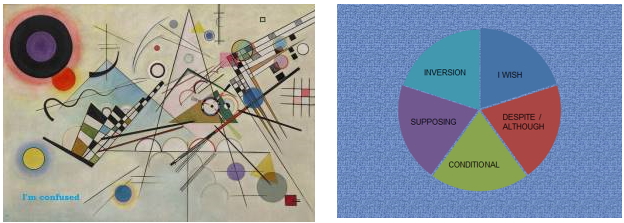
#grammar #grammarwheel #dontbeconfused #kandinsky
5. The Art of Living
This activity is really simple and has been inspired by the Ukrainian artist Alexey Kondakov’s digital collages, in which classical characters are superimposed onto modern-day scenes of contemporary life.
What can you do in a lesson?
Ask students to simply describe pictures when revising e.g. Present Continuous or vocabulary for comparing pictures. The value of the exercise lies in its simplicity and the element of surprise.
Most of the characters in Kondakov’s collages come from Pre-Raphaelite, Renaissance, Baroque, and Neoclassical works. Ask students go back in time to the respective epochs which inspired Kondakov and show them sample questions such as: What means of transport were available at that time? (picture 1) Did public libraries/bookshops exist? (picture 2) What did it mean to be a (homeless) child at the time? (picture 3) Was it possible for young women to play sports 200 /300 years ago? (picture 4). After you have given students an idea, get them to generate more questions keeping in mind that looking for answers will require doing some research.
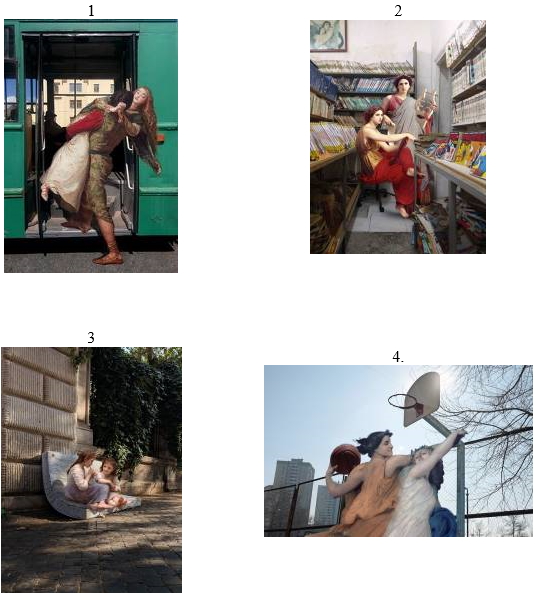
#AlexeyKondakov #digitalcollage #contemporarylife #whatlifewaslikebackthen #research
6. A Bigger Picture
This task will keep students busy for some time and is an excellent, yet simple exercise in developing creativity and the art of noticing. The idea behind it is for students to return to the pictures they have already reflected on and notice and reflect even more.
Ask your students to:
- Choose 5 pictures (you can leave it to students or provide links of your choice).
- Write down what they can see in them.
- List associations each picture triggers (with people, places, songs, poems, words, other images,etc.)
- Go back to them after some time (e.g. 3 or 4 weeks)
- Repeat the exercise and compare the descriptions, paying special attention to new thoughts/associations
Help them by providing a handout for their notes and joining the project yourselfJ.
#5pictures #reflect #reflectagain #4weekslater #joinyourstudents
7. The Art of Writing
RAFT strategy with artworks (by Santa, Havens and Valdes)1
This writing strategy helps students understand their role as a writer and communicate their ideas clearly by developing a sense of audience and purpose in their writing. RAFT strategy lends itself easily to being used with various works of art as they are an inspiring source of ideas, details, as well as a variety of perspectives.
Before students start writing, ask them to answer the questions about the photo below, taken by the World Press Photo winner, John Moore.
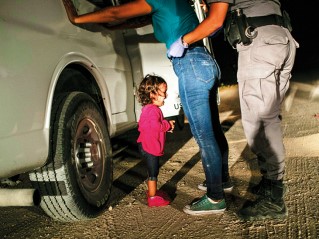
- What do you notice in the foreground and background?
- Where could it be happening?
- What might their clothes and belongings tell you about them?
- What do you think these people were doing just moments ago?
- What is going to happen next?
How to go about it?
- Explain what RAFT strategy is:
R – Role of the writer - Who or what are you as the writer?
A – Audience - Who are you writing for/to?
F – Format - a letter, a speech, a diary entry, a dialogue, etc.?
T – Topic
- Show students the chart and ask them to choose one of the roles, together with the type of audience they want to address, the format and topic.
|
ROLE |
AUDIENCE |
FORMAT |
TOPIC |
|
The child |
new friend some time later |
story |
coming to the USA |
|
The mother |
reporter |
interview |
why she left Honduras |
|
US border official |
his superiors |
report |
taking sb into custody |
- Before they start writing, give students some time to put themselves in the role they have chosen with the help of the Role Development Chart below.
|
Personality |
Attitudes |
Information |
|
Who am I and what are some aspects of my character? |
What are my feelings, beliefs, ideas, and concerns? |
What do I know that I should share in my writing? |
- Ask them to do the writing. To do it well, they might have to do some reading/ research. Allow ample time for it, perhaps as homework.
#art&writing #RAFTstrategy #iamawriter #thinkbeforeyouwrite #worldpressphoto #johnmoore
Activities 8 – 13 have been all inspired by Edward Hopper’s Nighthawks
8. Where Is Everybody?
The inspiration for the exercise comes from www.ymageworks.com, which contains edited versions of some famous paintings, in this case Edward Hopper’s classic Nighthawks.

This version gives students an opportunity to ‘people’ the picture, imagine the scene, the atmosphere, and the characters, etc. After they have done that, show them Nighthawks and ask to compare their version with the original one. You can also choose to explore some of numerous parodies of the painting. You can find them here https://bit.ly/2Tar950

#EdwardHopper #original #whereiseverybody #compare #parody
9. Q&A with Edward Hopper
This seemingly simple activity, if well thought over, offers students an opportunity to both concentrate on the painting and go beyond it, while practising some of HOTs (Higher Order Thinking skills) from Bloom’s taxonomy of cognitive skills.
- What is happening in this picture?
- Where are the two people sitting?
- Are the man and woman a couple?
- Where are they coming from?
- Where are they going?
- Who is the man with his back to us?
- How did he end up in the diner?
- What is the waiter’s life like?
- What is causing his distress?
- How would you describe the painting to others?
- What do you know about their lives based on this photo?
- How can the title be interpreted?
- Does knowing that the picture was painted during WW2 influence your understanding of it? Does it matter at all?
- If you met the painter, what five questions would you ask him and why?
- Use the Venn Diagram to explore the similarities and differences between Nighthawks and another painting of your choice (by E.Hopper or another artist)
- Imagine that you are one of the characters. Write a diary entry detailing his/her thoughts.
- Role-play a dialogue between 2,3 or 4 characters.
- Create a new character to add to the story.
- Do you know any other paintings/poems/songs /stories or films about loneliness and isolation?
#asktherightquestions #HOT #Bloomstaxonomy
10. Beyond a Sketch
Edward Hopper and his wife Josephine kept a journal with sketch-drawings of each of his paintings and a description of technical details. His wife would then add additional information about the theme of the painting.
Here are some of her notes – an inspiration for students whose task is to turn them into a full description of the painting, paying special attention to tenses and articles.
Night + brilliant interior of cheap restaurant. Bright items: cherry wood counter + tops of surrounding stools; light on metal tanks at rear right; brilliant streak of jade green tiles 3/4 across canvas--at base of glass of window curving at corner. Light walls, dull yellow ocre [sic] door into kitchen right.
Very good looking blond boy in white (coat, cap) inside counter. Girl in red blouse, brown hair eating sandwich. Man night hawk (beak) in dark suit, steel grey hat, black band, blue shirt (clean) holding cigarette. Other figure dark sinister back--at left. Light side walk outside pale greenish. Darkish red brick houses opposite. Sign across top of restaurant, dark--Phillies 5c cigar. Picture of cigar. Outside of shop dark, green. Note: bit of bright ceiling inside shop against dark of outside street--at edge of stretch of top of window.2
This activity can also be done the other way round – find interesting descriptions of various paintings and get your students to turn them into short notes.
#fromnotestotext #fromtexttonotes #descriptions #detailsmatter
11. It’s All in the Detail
More advanced students can work on a film with a detailed description and interpretation of Nighthawks. https://bit.ly/2VfMIE0
Before students watch the film, ask them to study the list below, look up definitions and use the words to reflect on the painting: (they all appear in the film)
|
|
They watch the film, paying attention to the words/phrases above, comparing their interpretation with the film, and then reporting back.
#listen&watch #beforeyoulisten #checkvocabulary
12. Put it back together
Apart from the film, the website https://bit.ly/2VfMIE0 contains a detailed, wonderfully written analysis of the painting, which can turned into a reading exercise:
- students get 4 paragraphs on seperate pieces of paper
- arrange them in a correct order
- match them with one of the titles below (there are more titles than paragraphs) :
- Near Misses
- The Light
- A Timeless Feel
- A Subtle Critique
- An Urban Isolation
- A Night out
#putitbacktogether #themainidea #read&understand
13. A match made in…the text
The text is quite challenging, but this simple matching exercise can help students to focus on more complex sentences, which they can later use as an inspiration in their own writing. https://bit.ly/2VfMIE0
|
In place of meaningful interactions,
|
Hopper was able to exploit stark pictorial devices
|
|
By setting the scene on one of New York City’s oblique corners and surrounding the diner with glass,
|
the four characters inside the diner of Edward Hopper’s Nighthawks are involved in a series of near misses. |
|
This feeling can be understood by comparing Nighthawks to Hopper’s earlier painting Early Sunday Morning.
|
invited to ask questions about the characters’ ambiguous lives.
|
|
Rather than a narrative about men and women out for a festive night on the town, we are |
Both paintings are set in front of the red brick apartments of New York’s Greenwich Village and show us an hour of the day when people are typically not awake.
|
Follow-up exercises:
Writing or Speaking: Simplify/paraphrase these 4 sentences
Speaking:
What is your definition of meaningful interactions? How can they be achieved? How do you feel about the quotes below?
- To have meaningful interactions, you should hone your listening skills.
- Speak as much as you are comfortable speaking.
- Some people feel more at ease when they type.
- The meaningful interaction is if you can make a connection of what you know about a subject that someone else also knows about.
- The purpose of conversation, at least to me, is to advance my knowledge.That’s what interaction is about.
- Life is better when you pay attention.
- If you don’t walk away feeling you know that person better than you did before, or at least “connected” to that person in some way, it is not a genuine human interaction.
As if that is not enough, there is also an external link on the page, https://bit.ly/2VfMIE0) where you can
view this painting up close in the Google Art Project and zoom in on the details. At the bottom of the page, there are links recommending other pictures according to different criteria, e.g.:
- paintings created around the same time,
- using the same medium,
- from a related movement,
- visually similar,etc.,
a wonderful source for exploring connections, comparing and seeing a new perspective.
#matching #paraphrase #lovelylongsentences #discussion #humanconnection #newperspective
14. Living picture
The idea of tableau vivant /living picture has been around for a long time, but it is still worth trying if you want to offer your students a bit of a different experience. The pictures below are self-explanatory and the article describes how it was organised in the USA. It is good to keep in mind the language potential of this project.You can either involve the whole group in staging the scene and concentrate on the ‘theatrical’ aspect, or focus more on the language by asking students to take turns and give detailed instructions to their group (about clothes, posture, position, facial expressions, etc.)
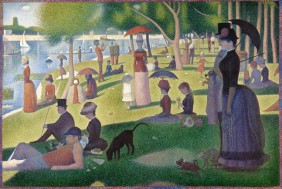
Georges Seurat - A Sunday Afternoon on the Island of La Grande Jatte
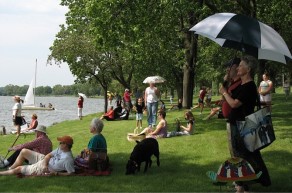
A recreation of the famous scene using local volunteers (Wisconsin, 2006)
https://mymodernmet.com/seurat-recreation-beloit/
#GeorgeSeurat #recreateascene #detailedinstructions
15. Instagram it
Social media are an invaluable source of inspiration and have hundreds of images available at a touch of the screen. The printscreens below come from the Instagram accounts of MOMA in New York and the National Museum in Warsaw.
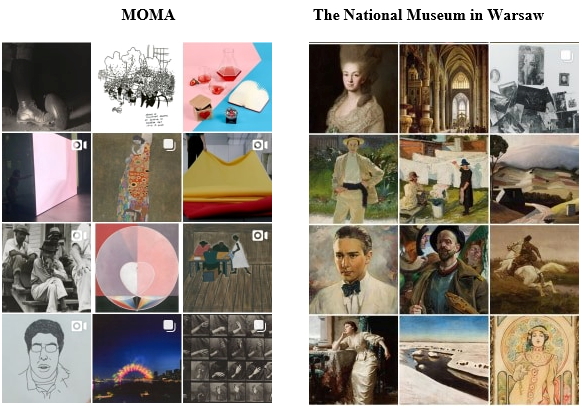
Simply display the printscreens and get students to:
|
|
References
- Santa, C., Havens, L., & Valdes, B. (2004). Project CRISS: Creating Independence through Student-owned Strategies. Dubuque, IA: Kendall Hunt
- Deborah Lyons, Edward Hopper: A Journal of His Work. New York: Whitney Museum of American Art, 1997, p. 63
Thanksgiving Lessons with Deeper Meaning
Malgorzata Bukowska-Ulatowska, PolandCare Global. Teach Local!: 12 Months of Social Issues - ELT Calendar of Special Days
Margarita Kosior, GreecePicture This, Picture That: How to Use the Potential of Art in Language Teaching
Magda Zawadzka, PolandAn A-Z Guide to Quizzes: A Memorable Way to Learn
Peter Whiley, UK/PolandThe Map is Not the Territory
Robert A. Buckmaster, Latvia/UK
